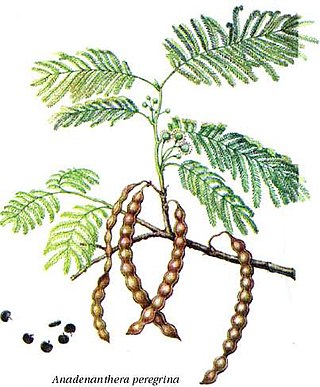
Anadenanthera peregrina, also known as yopo, jopo, cohoba, parica or calcium tree, is a perennial tree of the genus Anadenanthera native to the Caribbean and South America. It grows up to 20 m (66 ft) tall, and has a horny bark. Its flowers grow in small, pale yellow to white spherical clusters resembling Acacia inflorescences. It is an entheogen which has been used in healing ceremonies and rituals for thousands of years in northern South America and the Caribbean. Although the seeds of the yopo tree were originally gathered from the wild, increased competition between tribes over access to the seeds led to it being intentionally cultivated and transported elsewhere, expanding the plant's distribution through introduction to areas beyond its original native range.

Baccaurea ramiflora, the Burmese grape, is a slow-growing evergreen tree in the family Phyllanthaceae, growing to 25 m, with a spreading crown and thin bark. It is native to Asia, from Nepal in the west, east to southern China and south to Peninsular Malaysia. It grows in evergreen forests on a wide range of soils. The fruit is harvested and used locally, eaten as a fruit, stewed or made into wine; it is also used medicinally to treat skin diseases. The bark, roots and wood are harvested for medicinal uses.

Kakum National Park, located in the coastal environs of the Central Region of Ghana, covers an area of 375 square kilometres (145 sq mi). Established in 1931 as a reserve, it was gazetted as a national park only in 1992 after an initial survey of avifauna was conducted. The area is covered with tropical forest. The uniqueness of this park lies in the fact that it was established at the initiative of the local people and not by the State Department of wildlife who are responsible for wildlife preservation in Ghana. It is one of only 3 locations in Africa with a canopy walkway, which is 350 metres (1,150 ft) long and connects seven tree tops which provides access to the forest.

Senna spectabilis is a plant species of the legume family (Fabaceae) in the subfamily Caesalpinioideae native to South and Central America. They are often grown as an ornamental in front yards, parks, gardens, buildings etc. due to their bright yellow flowers that bloom during the summer months. They are also known as golden wonder tree, American cassia, popcorn tree, Cassia excelsa, golden shower tree or Archibald's cassia.

Aglaia argentea is a species of plant in the family Meliaceae. It is a tree found in Australia, Brunei, India, Indonesia, Malaysia, Myanmar, Papua New Guinea, the Philippines, the Solomon Islands, and Thailand.

Distemonanthus is a genus of flowering plants in the family Fabaceae. It belongs to the subfamily Dialioideae. It contains a single species, Distemonanthus benthamianus, a deciduous tree, which occurs widely but sparsely in the forest regions of Tropical West and Central Africa; it is sometimes confused with Pericopsis laxiflora due to similar morphological features.

Guiera is a flowering plant genus in the family Combretaceae. Guiera senegalensis is the only known species in the genus, found in Tropical Africa in dry areas from Senegal to Sudan. The plant produces the tannin 3,4,5-Tri-O-galloylquinic acid and several alkaloids of the harmane family.

Rubus ellipticus, commonly known as ainselu, golden evergreen raspberry, golden Himalayan raspberry, or yellow Himalayan raspberry, is an Asian species of thorny fruiting shrub in the rose family. It is native to China, Nepal, India, Pakistan, Indochina, and the Philippines.

Pittosporum viridiflorum is a protected tree in South Africa.

Culcasia scandens is an African climbing plant, often epiphytic, with slender, wiry stems, up to 5 m long clinging to tree trunks by means of clasping roots, and growing on forest and stream margins and in savanna. It is native to countries of western tropical Africa from Senegal east and south to Angola.
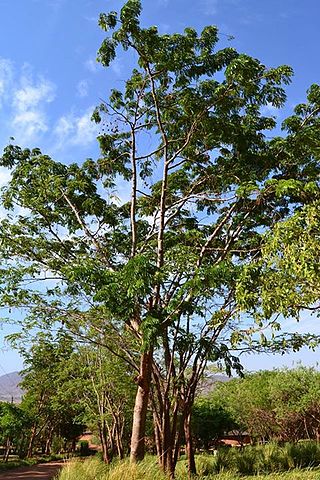
Parkia filicoidea, or African locust bean, is a large, spreading flat-crowned tree to 30 metres tall, the bole of which may be narrowly buttressed to a height of about 3 metres, and up to 120 cm DBH. It occurs in wet evergreen or semi-deciduous forest, sometimes on forest fringes, riverbanks and lakes, termite mounds, at elevations up to 1000 metres from Côte d’Ivoire, east to Sudan and Somalia, Uganda, Kenya, Malawi and south to Angola, Zambia, Zimbabwe and Mozambique. Bark on trunk scaly or smooth, grey to yellow-brown, branchlets glabrous to puberulous.
Premna mollissima, the dusky fire brand mark, is an 8m high small tree in the family Lamiaceae. It is found in India, Bangladesh, and Sri Lanka.

Sterculia africana or African star-chestnut is a deciduous tree, belonging to the genus Sterculia and the family Malvaceae. The species is sometimes called the "mopopaja tree". It is distributed throughout Northeast Africa to Arabia.

Calophyllum polyanthum is a species of flowering plant belonging to the genus Calophyllum of the family Calophyllaceae, commonly known as the poonspar tree, sirpoon tree, punnapine, pinnapai, punnappine, kattupunna and malampunna. This tree is native to the Western Ghats in India, where it grows in abundance there. It is also found in Andaman & Nicobar Island, Bangladesh, Bhutan, Laos, Myanmar, Thailand and Vietnam.
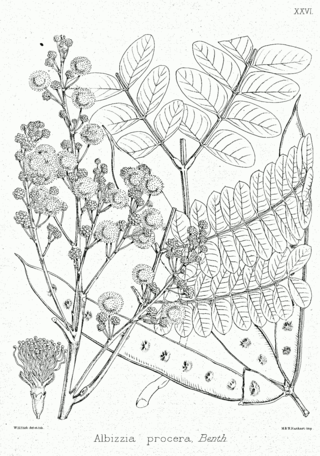
Albizia procera, commonly known as white siris or karoi tree, is a species of large tree found natively in southeast Asia and India. It is most commonly found in open forests, but may also be found on the margins of rain forests and in monsoon and gallery forests. It is considered an invasive species in South Africa.
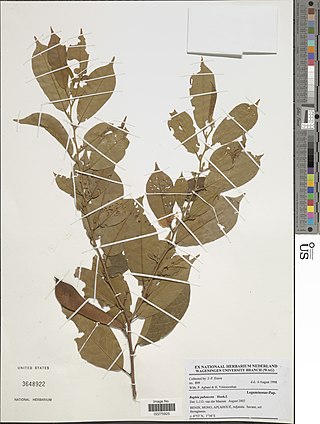
Baphia pubescens is a medium size tree common in Guineo-Congolian forest. It is known as odwenkobiri in the Akan language of Ghana.

Garcinia cowa, commonly known as cowa fruit or cowa mangosteen is an evergreen plant with edible fruit native to Asia, India, Bangladesh, Myanmar, Malaysia, Vietnam, Laos, Cambodia, and southwest China. The tree is harvested from the wild for its edible fruits and leaves, which are used locally. Flowers are yellow, male & female flowers are separated.
Uapaca heudelotii, also known as rikio des rivières, is an evergreen plant in the family Phyllanthaceae. It is found in western Tropical Africa and is always located in wet places, mostly on river borders as it stabilizes the soil.
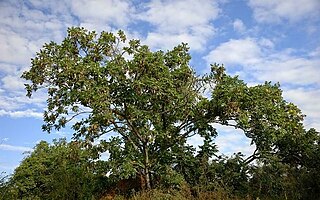
Aganope stuhlmannii is a deciduous tree within the family Fabaceae. It is native to tropical Africa and grows in savanna woodlands.
Cussonia holstii is a small to medium size tree belonging to the family Araliaceae. The tree is similar in shape to a paw paw tree.





















